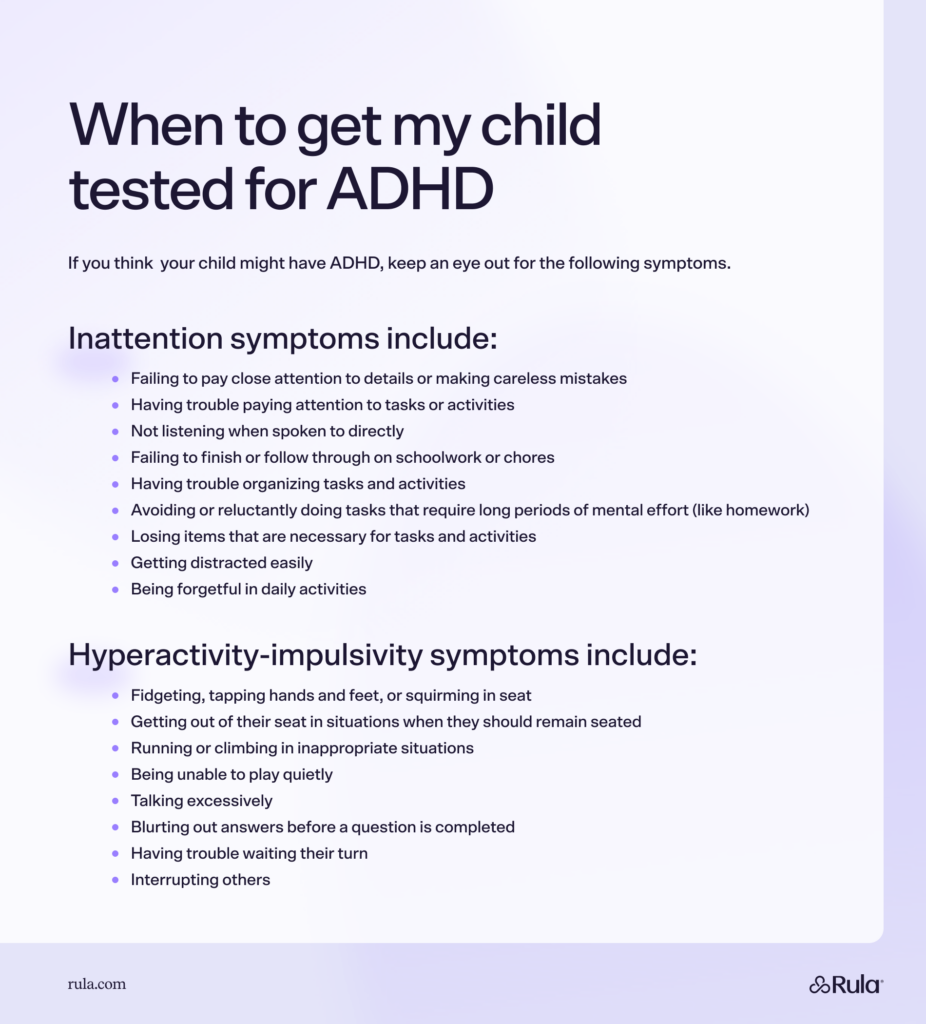Attention-deficit/hyperactivity disorder (ADHD) is a common childhood neurodevelopmental condition that can affect your ability to concentrate, follow directions, and control impulsive behaviors.
Diagnosing ADHD is a comprehensive process that typically involves a clinical assessment, medical evaluation, symptom evaluation, family health history, and ADHD questionnaires.
If you think your child might have ADHD, the first step is to have them evaluated by a qualified healthcare professional, like a pediatrician, clinical psychologist, or psychiatrist.
As a parent or caregiver, it can sometimes be tough to know what’s expected kid behavior and what’s not. For example, it’s common for children to occasionally have trouble paying attention or waiting their turn. But when these behaviors start to impact their academic performance or ability to connect with others, it may be a sign of an underlying condition, like attention-deficit/hyperactivity disorder (ADHD).
ADHD is the most common childhood neurodevelopmental condition, affecting up to 10% of school-age children. Children with ADHD often have trouble concentrating on tasks, following directions, and controlling impulsive behaviors. This can cause issues at school, at home, and with their self-esteem.
The average age for an ADHD diagnosis is seven years old, but most children begin showing signs even earlier. Children can be evaluated for ADHD starting at age four, so here’s everything you need to know about the diagnosis process, who to consult, and the most effective treatment options for managing the condition.

How is ADHD diagnosed in children?
Identifying ADHD in children isn’t always straightforward. Providers often rely on clinical assessments, medical evaluations, family health history, and ADHD questionnaires to make a diagnosis. This allows them to better understand a child’s symptoms and rule out other mental health conditions, including anxiety disorders, mood disorders, and personality disorders.
According to the American Psychiatric Association, a child must show signs of inattention and/or hyperactivity and impulsivity by the time they turn 12 to be diagnosed with ADHD. Symptoms should be present in two or more settings, like at home and at school, and they must noticeably impact a child’s quality of life.
Children ages 4 to 16 years must exhibit six or more inattention symptoms and/or six or more hyperactivity-impulsivity symptoms. These symptoms must be inappropriate for their developmental level and be present for at least six months.
Inattention symptoms include:
Failing to pay close attention to details or making careless mistakes
Having trouble paying attention to tasks or activities
Not listening when spoken to directly
Failing to finish or follow through on schoolwork or chores
Having trouble organizing tasks and activities
Avoiding or reluctantly doing tasks that require long periods of mental effort (like homework)
Losing items that are necessary for tasks and activities
Getting distracted easily
Being forgetful in daily activities
Hyperactivity-impulsivity symptoms include:
Fidgeting, tapping hands and feet, or squirming in seat
Getting out of their seat in situations when they should remain seated
Running or climbing in inappropriate situations
Being unable to play quietly
Talking excessively
Blurting out answers before a question is completed
Having trouble waiting their turn
Interrupting others
Dig deeper:
The care you need, when you need it
Learn how Rula can support your mental health journey
Who can evaluate children for ADHD?
If you think that your child might have ADHD, the first step is to have them evaluated by a qualified healthcare professional. ADHD can be diagnosed by several types of professionals, including pediatricians, clinical psychologists, and psychiatrists.
For many families, their pediatrician is the first point of contact when discussing ADHD. In fact, more than half of children with ADHD were diagnosed by primary care physicians, according to research from the CDC. From there, pediatricians will often refer families to providers who specialize in treating and preventing mental and behavioral health conditions, like psychologists and psychiatrists.
To help conduct a more complete evaluation, healthcare providers may also request information from your child’s school psychologist or teachers. Although school professionals aren’t always able to make a diagnosis, they can share useful information about your child’s learning patterns, behavior in the classroom, and how their symptoms affect their progress at school.
Dig deeper:
Where can children get tested for ADHD?
If your child is showing potential signs and symptoms of ADHD, consider getting them evaluated right away. Caregivers can request a school-based evaluation for ADHD or bring their child to a clinical setting, like a pediatric clinic, psychiatrist office, or behavioral health center.
Here are a few tips for choosing the most appropriate and accessible venue for your child’s ADHD evaluation.
Ask for referrals. Consider seeking referrals from reputable sources, like your child’s school, pediatrician, or other parents who have been through a similar experience.
Review credentials. Choose a provider with the right qualifications and experience to diagnose and treat ADHD in children.
Consider cost. It’s also important to consider cost. Ask if the assessment is covered by insurance or if there will be any out-of-pocket fees.
Factor in availability. Choose a venue with reasonable availability so that you can avoid major delays in assessment and treatment.
Effective symptom management options for childhood ADHD
There’s no cure for ADHD, and it’s important to remember that ADHD is a form of neurodivergence. This means it’s a normal variation of the human brain that comes with both challenges and potential benefits. However, children with ADHD may benefit from accommodations to help them manage their symptoms and improve their quality of life. ADHD symptom management varies based on a child’s age, symptoms, and unique care needs. But it typically involves a combination of behavioral interventions, medication management, and accommodations.
Behavioral therapy focuses on reducing or managing unhealthy behaviors. It provides children with coping strategies, organizational skills, and time-management techniques to manage symptoms and improve functioning. Parent training is another effective therapy for ADHD because it teaches caregivers more helpful ways to support their children’s needs and respond to their ADHD symptoms.
Medication can also help children with ADHD. The FDA has approved two types of medications to help manage symptoms of ADHD and improve functioning in children ages six years and older.
Find care with Rula
If a child in your life is showing signs of ADHD or has recently received an ADHD diagnosis, one of the best things you can do is connect them with quality mental healthcare. Rula’s diverse network of therapists offer specialized care to help children and their families navigate ADHD and other mental health conditions.
Using Rula, you can easily find a therapist who has experience treating ADHD, is taking new clients, and accepts your insurance — all from the comfort of your home. Plus, with Rula, you have access to psychiatric services for medication management to ensure effective, collaborative care.
Rula's editorial process
Rula's editorial team is on a mission to make science-backed mental health insights accessible and practical for every person seeking to better understand or improve mental wellness.
Members of Rula’s clinical leadership team and other expert providers contribute to all published content, offering guidance on themes and insights based on their firsthand experience in the field. Every piece of content is thoroughly reviewed by a clinician before publishing.




